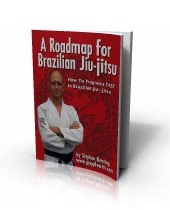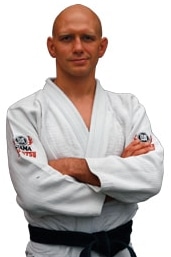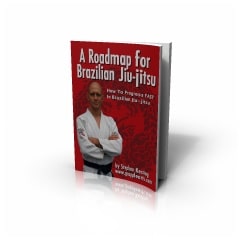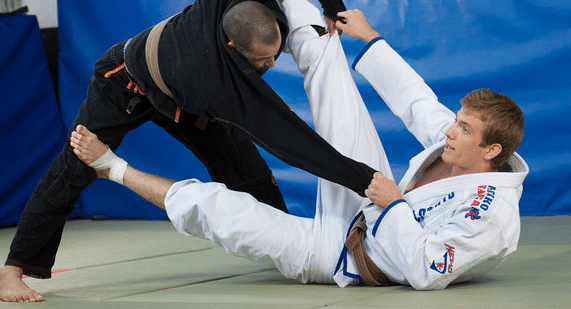
Keenan Cornelius is a BJJ phenomenon. Known for his exciting guardwork and movement-oriented game, he won double gold medals in four of the biggest BJJ tournament in the world as a purple belt, which is a HUGE accomplishment. Here’s my recent interview with Keenan where we had an in-depth conversation about training, BJJ competition, conditioning, gi vs no gi, MMA, strategies and gameplans, and his switch from Team Lloyd Irvin to Team Atos.
Click Play Below to Listen to My Conversation with Keenan Cornelius…
Also thanks to the readership of the Grapplearts newsletter which provided many of the questions for Keenan.
This podcast episode, along with all my others, are available on my Strenuous Life Podcast, which you can subscribe to with a few easy clicks! Choose your audio player below and click on it to open up The Strenuous Life Podcast and from there, you can click to subscribe, or simply search for this episode which is episode # 14.
- Apple Podcasts (the purple app on your iPhone)
- Google Podcasts (the new google podcast app)
- Spotify (it’s free)
- Stitcher,
- Soundcloud,
- Google Play
Stephan: Hey everybody, Stephan Kesting from Grapplearts.com here. Today, I’m interviewing Keenan Cornelius and if you don’t know he is, well, you really should. He’s a prodigy. There’s just no other way to describe him.
Keenan has achieved the very first grand slam in Brazilian Jiu-Jitsu at his level. He has double gold medals at the four biggest tournaments in the world at brown belt. He just destroys people and his skills are off the hook. So I’m super glad to be talking with him today.
So Keenan, how are you doing?
Keenan: I’m doing great. Thank you for that lovely introduction.
Stephan: Could you just get us started by telling a little bit about your background – where you grew up, how you got started in grappling and who you’ve trained with?
Keenan: I grew up in Hawaii actually. I was born in Kona, Hawaii and I lived in Hilo, which is actually where BJ Penn is from, for seven years. Then I moved all around throughout the mainland – the United States – living in California, Nevada and Florida.
I didn’t really get into Jiu-Jitsu until I was 14. It was my 8th grade summer so I was about 14 and a half and I had trained taekwondo up until that point. My dad, Tom Callos – he’s my stepdad but he raised me pretty much – is a 6th degree in taekwondo and he’s owned multiple martial arts schools.
But he was also a blue belt in Jiu-Jitsu from when my mother first met him but I never really trained Jiu-Jitsu with him until I was about 14. And he was actually the guy who introduced BJ Penn to Jiu-Jitsu – BJ started training at my dad’s taekwondo school not in a class but more as just a workout for my dad himself, he’s just trying to find people that he could train with and do Jiu-Jitsu. You know how the Jiu-Jitsu bug is; once you started doing it, you just got to keep rolling.
Stephan: So who’s more flexible – you or BJ Penn?
Keenan: I don’t know. We have to have like a flex off or something. At one point we could both throw our legs behind our heads without using our hands so I don’t know how you could see who’s more flexible after that point; that’s pretty much max flexibility, so I don’t know!
So I started training with my dad in California. We just trained out of our garage. We had some mats in there and I just recruited some local wrestlers from my high school and who are my fans. We also sort of started learning off YouTube and just picking up where we could. And I trained like that for about two years with like occasional trips to more legit gyms, like Cassio Werneck’s gym in Sacramento, and eventually got my green belt.
After about a year, and after winning some white belt competitions, I decided that I wanted to do Jiu-Jitsu for the rest of my life. I was 16 at that time when I decided to take my GED which is the General Equivalency Diploma; basically a high school diploma for the kids who messed up – the kids who aren’t really going to graduate or they don’t have the grades to actually get the real diplomas so they’re just going to take a test to show that they’re functional human beings.
I chose to do that just because as a way to get out high school so I can train full time. I took my GED when I was 16, so technically I dropped out of high school to train full time and I moved to Hawaii to train with BJ Penn because my dad had a connection with and he was always an idol of mine. And so I was in Hawaii for three years from 16 to 18 years old.
After that I moved to Maryland because I was looking for a more Jiu-jitsu competition-focused environment because in Hawaii I was more MMA-focused and things were a little laid back as far as the actual Jiu-Jitsu instruction. I was at Team Lloyd Irvin for two years almost exactly. I got there on January 27, 2011 and then I left in February 2013.
Stephan: While you were there, what was that like as a training environment?
Keenan: It was awesome. One thing Lloyd Irvin did really well was facilitate an environment for people who just wanted to train full time. We have a great facility. There are great trainers and partners there. Everyone was very passionate about Jiu-Jitsu and we have opportunity to train full-time and not have to worry about too much.
He had a fighter house that he would let us stay in rent free and we just trained full time with guys like JT Torres and Jimmy Harbison and DJ Jackson. They’re all killers and they’re all very passionate. And it was kind of like a sandbox-type format and there wasn’t too much conventional teaching environment where you might show up, warm up, learn two or three techniques and then we roll for a little bit and leave.
Instead it was like: we’d show up, we’d drill for an hour of whatever we want with Lloyd Irvin supervising from the sidelines, and then we just roll forever. Hours of actual time spent training hard – like full on sparring. That kind of environment isn’t for everyone because some people need more instruction than others. But we were all very passionate about it. We studied intently on YouTube, watching the best guys and all kind of learned from each other. This really opened up our minds to be creative about our own style and that’s why everyone from there has developed sort of a different style.
I was more of a flexible guard player. I sort of went towards the berimbolo route and the leg drag type passing, whereas JT was more of a pressure passer, and DJ obviously would take down and pass – everyone sort of developed a different game whereas in a conventional environment everyone sort of just picks up what their instructor teaches. Like the Marcelo Garcia guys – everyone plays Marcelo’s game basically.
And I think it’s important to have that freedom to grow in your own way. Obviously Lloyd Irvin taught us a lot of stuff, but it wasn’t in the conventional sense: it was more competition mindset, giving us moves that he thought worked for our body type and it was really a great experience as far as the training.
Stephan: The elephant in the room, when we’re talking about Team Lloyd Irvin, is why did you leave?
Keenan: Well personally Lloyd Irvin never did me wrong. He never screwed me over in any way. He really facilitated my dream which is to train full time. Obviously the unsavory stuff then came to light that none of us had really known about. It’s pretty obvious why we all left, though DJ is still over there which we found out was for another obvious reason…
But you know what? Overall, I really enjoyed my time there. I haven’t experienced anything bad up until that point and sometimes all good things must come to an end. Like you said it’s an elephant in the room. There was an elephant in the closet over there and it eventually burst out. And so once that came to light, we all had kind of have to do what was right.
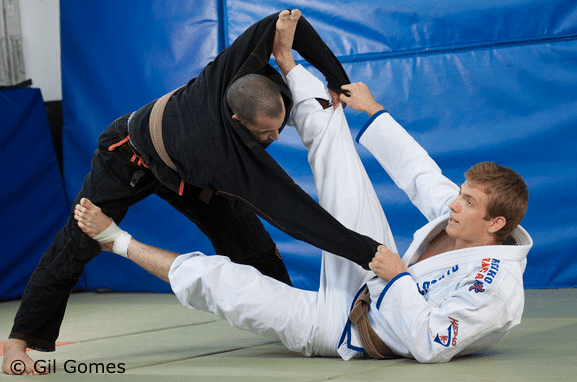
Stephan: So you’re at Atos now, correct?
Keenan: Yes. I trained with Andre Galvao in Atos and it’s awesome over there.
Stephan: And what’s the training environment there compared to the training environment that you had previously? Are there major differences in how you structure your day?
Keenan: Yeah. It’s a little different. In Maryland, we were trained with two really hard training sessions per day with one smaller, lighter drilling-only session in the middle of the day. So it’d be like 11:00 a.m. to 1:00 p.m. or 2:00 p.m. and then we come back at 8:30 p.m. and then train to 10:30 p.m. or 11:00 p.m. or 11:30 p.m. depending on the night.
So we have a lot of time in between to rest – between those two big training sessions – where at Atos it’s a little more packed together. It is three training sessions in a span of six hours so there’s not a whole lot of rest time and it kind of wears down your body. Well, I guess I’m just not used to that different style yet but it’s different but it’s not bad – it’s just a different way of doing it. Obviously, it works when you have guys like Andre Galvao coming out of there and the other killers from the Atos gym like Michael Liera and Mike Carbullido and those guys – so I’m looking forward to it; I’m just keeping an open mind.
And I really enjoy the different type of instruction as well because Andre Galvao is on the mats everyday, training full time just like the rest of his competition team. He’s there; when we all have to be there at 9:00 in the morning to do the first training session, he’s there with us warming up. That’s a really powerful thing to have someone so high level on the mats with you all the time to beat you up and expose the flaws in your game…
Stephan: (Interrupting) It keeps you honest…
Keenan: Yeah. Exactly.
Stephan: So what do you mean by drilling? Do you mean repeating the technique over and over and over, or do you mean drilling specific positions where you’ll start in side mount and the person will try to get out… What do you mean by drilling?
Keenan: Drilling sort of it encompasses all those things I think. There are different types of drills. You’ve got your repetitive drills where you do a small motion over and over again like drilling like a leg drag or something as quickly as possible. Usually we do this in a timed setting where it might be two minutes on, 30 seconds off. So it’s intensive cardio-wise and then you switch to another type of pass, maybe like the Toreana back and forth, or whatever…
And then you’ve got drilling which is like drilling your sweeps where you just drill the technique without intensity, just doing it and going through it over and over again trying to get reps in on it.
And then, like you said, you’ve got the positional drilling where you’re starting from a position like being on the back and you have a goal which is to not lose the back and to finish your opponent.
I don’t know if anyone has the secret recipe for how much of each type of drilling you need to fit in to maximize your learning and your understanding of those moves, but I personally like the chill type of drilling. Drilling is never really something I enjoyed. I like live rolling, I like the sparring, I think that’s the most fun. Seeing myself improving there is what keeps me passionate about Jiu-Jitsu. But I understand drilling is important so I do it, but I’m not going to say it’s my favorite part of the day.
Stephan: So when you’re working on techniques these days, how much of it is new stuff that you want to incorporate into your game, and how much of it is reinforcing stuff that you already have which you’re trying to get to work even better?
Keenan: Yeah. I was actually talking about this earlier with someone and I personally like to incorporate as much new stuff as possible. I think it’s easy to get stuck in a rut where you think you’re a certain type of Jiu-Jitsu player; like your sweep is an X guard sweep, or you play half guard, or you pass over-under, and that’s what you do and you just do it over and over and over again.
I think what’s so beautiful about Jiu-Jitsu is how infinite it is, and I think it’d be silly to not try and add as much as possible. So I like to add new things and I especially like to create new things, come up with things that I’ve never seen before and experiment with the positions. And that’s actually a lot of what I’m teaching on my upcoming DVD series: a lot of the moves that I’ve sort of come up, with or have seen and adapted to fit for me and work for me.
So that’s why I say I like the chill type of drilling because it allows me the time to actually experiment with positions, try new things, come up with the different sweeps, and come up with different concepts that I can add.
Stephan: So clearly if you’re doing that, you pretty much need to be drilling with people roughly your own level or not too far below, so that you’re dealing with reactions that are realistic…
Keenan: Yeah. One of my favorite drilling partners is Jordon Schultz. Jordon and I have some really productive drilling sessions together. Like me he’s very open to trying new things, unlike some of the other guys who are a little more resistant to that and just want to get their reps in for their one move. They kind of don’t like when I play around the different positions and start playing with people’s lapels and doing funky stuff. But me and Jordon, we really have a lot of fun drilling together so he’s obviously high level. He’s a two-time world champion so I’m really glad he’s at Atos with me now.
Stephan: Now when you get to the part of training that you really love the most, which is the sparring, how much gi vs. no gi do you do? I’m guessing it depends on what your next competition is…
Keenan: Yeah. I pretty much do gi year round except for the couple months before No Gi Worlds and then I do pretty much pure no gi. So probably for 80% to 90% of the year I’m in the gi and then the rest I’m training no gi.
Training in the gi is like training no gi with weighted clothing. So when you finally take the gi off, you just feel so fast and light and it’s no problem. It’s a simpler version of Jiu-Jitsu, so it’s easy to transition from the gi to no gi. So I actually have found that sometimes I do better at no gi tournaments when I train in the gi for them.
Stephan: Just like Marcelo Garcia before he came onto the scene at his first Abu Dhabi. He had only been training gi…
Keenan: Right. Because there’s so much more you can do in the gi as far as manipulating the grips, or having someone grab you and having such control over your legs and putting pressure down on you… It becomes very mental…
Stephan: But don’t you then become dependent on those gi grips?
Keenan: Not at all. I guess if you let it, it can affect you, but it’s a lot harder for a no gi guy to start training the gi than a gi guy to go no gi, because the concepts are still the same: you’re still playing guard, you’re still trying not to let someone pass your guard… I feel that no gi becomes a little bit more about athleticism and speed, and gi is a little bit more about actual technique. There are some no gi guys out there that don’t want to hear that, but that’s generally how I feel…
Stephan: (Laughing) It’s your interview. You can say whatever you like…
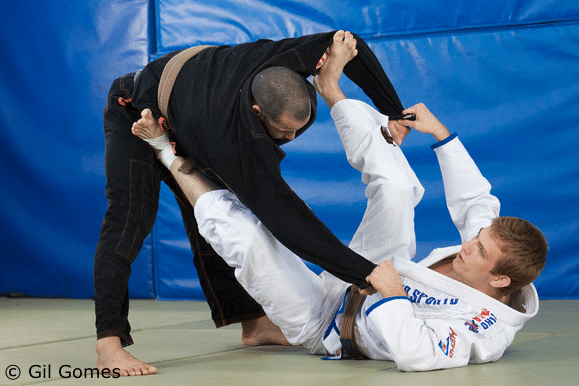
Keenan: I’ve trained both extensively. I used to only train no gi. Like the first two years when I started, and then for about a year at BJ Penn’s I wouldn’t put on a gi. And then, finally, I started forcing myself – because I heard about guys like Marcelo who swear by training gi – I started doing it and that’s what I really fell in love with the training in gi.
Stephan: Okay. Now speaking of athleticism and explosiveness and strength, do you do any additional conditioning, either strength or cardio in addition to all the training that you do? Or do you find that the amount of training that you’re doing – because you can train for six hours a day – is enough?
Keenan: Yeah. I feel like if you don’t have the option for doing strengthening and conditioning then you should definitely be doing as much Jiu-Jitsu as possible and I think you can do fine with that. I actually did most of my purple belt year competitively without doing very much strength conditioning at all. There was a little bit of a conditioning class but I wouldn’t really go into it very often; I was mostly just about rolling live.
Especially at the lower belts I wouldn’t stress conditioning as much because conditioning is the complete opposite of skill in Jiu-Jitsu, right? Like we’re trying to improve our strength and our speed but if you don’t have strength and speed, it forces you to use better technique. So especially in your beginning stages of Jiu-Jitsu I think you should just focus on the Jiu-Jitsu itself. It’s a good workout. You’re using all your muscles. You’re not going to getting to super jacked – it’s not strength training of course – but it does force you to really focus on the technique.
When I was younger and starting out I was a lot skinnier and weaker and it really helped me. I was forced to adapt to deal with the bigger, stronger guys. And that’s part of the reason why my guard got to where it is today; just being in that situation. So if you’re doing conditioning, it’s really purely only for competition in my opinion.
I mean I do strengthening and conditioning now. Just to clarify: I do strength training mostly. I’ve done some crossfit type training and I’ve done some explosive style training but I feel that there isn’t it a lot of explosion of Jiu-Jitsu unless you’re standing.
So I feel that just basic, meat head type lifting is actually really good for Jiu-Jitsu, so I try to stick to that. I’ve had a lot of success with that. I feel really good when I’m feeling strong like that. But that’s not for everyone. I’m a lean guy so I put on muscle it’s not a lot of muscle but it really helps me a lot. But if you’re already a big guy, you should probably try and lean down a little. You do more flexibility type stuff and more cardio…
Stephan: How much flexibility type stuff or stretching do you do currently?
Keenan: Actually I hadn’t really done any ever. I had never done yoga and just did yoga for the first time…
Stephan: (Laughing) I hate people like you…
Keenan: (Laughing) But the thing is like when I did yoga, I was actually very inflexible in it. I couldn’t do most of the positions because my flexibility is very limited. My game puts me into the positions that I’m flexible in…
I can’t touch my toes really. As far as hamstring flexibility goes, I’m very inflexible. I’d say much less flexible than your average guy in my hamstrings, but I have extreme flexibility in my hips and my foot-to-face flexibility. So yoga made me realise that I have Jiu-Jitsu flexibility… Doing Jiu-Jitsu just keeps me flexible whereas doing yoga its making me flexible for yoga not for Jiu-Jitsu. Does that make sense?
Stephan: Yeah. Sports specific flexibility.
Keenan: So I’m not a fan of yoga. I’m not going back to yoga.
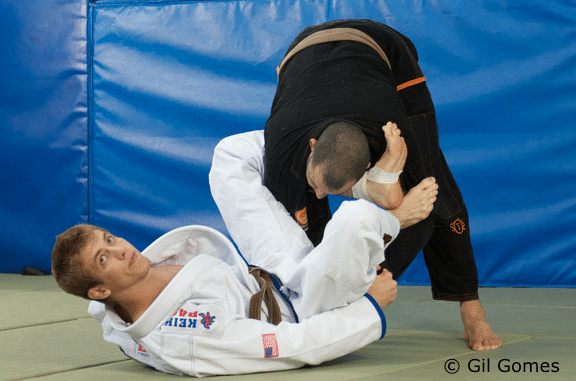
Stephan: With all the training that you’re doing, how are you with injuries? How often are you training while you’re injured?
Keenan: I have actually been really good about injuries lately especially since the strength training. When I wasn’t lifting as much, I felt like my joints weren’t really supported, maybe because they’re so flexible. So I had a lot of tendon or ligament injuries on my knees and sometimes my spine would get hurt. But once I started lifting and had a little bit more support from the muscles I haven’t had very many injuries at all. And that’s just because Jiu-Jitsu is pretty low impact for the most part. And when you reach a certain point, it becomes very flowing. When you have a good training partner, and both people are equal level, then there’s not a whole lot of spazzing out or people putting you in weird positions. You know the limits of your body and you’re not going to put yourself in a place where you kind of get injured.
From what I’ve seen, most injuries to sports competitors aren’t from training itself. They are from strength and conditioning and crossfit and stuff. So that’s another reason that I avoid that kind of explosive stuff.
Stephan: It’s a really interesting perspective. What you’re saying is that what you call the ‘meat head’ weightlifting seems to protect your joints…
Keenan: Yeah. I’m sure it’s different for everyone. Everyone’s body but I feel like when I have a little bit more strength it keeps me from getting stacked in bad positions – awkward, uncomfortable positions – just because I’m a little stronger. So that could be it, or it could be that my joints actually have more support. I don’t know but whatever it is, I haven’t had a serious injury in months. Knock on wood.
Stephan: Let’s talk about the whole competition thing. You’re known for your amazing competitive record. How many competitions do you figure you’ve done?
Keenan: I’ve been flying around a lot lately, going all over the country doing different things and. During my time on the planes I’ve been trying to compile a list of all the matches that I’ve ever had. And I couldn’t do it; there are too many. I’ve competed a lot. I don’t think I even got through my first two years before I was like, “Nah. This is too much. I can’t remember them.”
In 2012, I had over 130 matches at purple belt. I lost once to a guy in Abu Dhabi.
And at brown belt so far I’m undefeated while facing other brown belts. I lost to some black belts. For example I lost to Cyborg in the Abu Dhabi trials. But so far at brown belt, I’m doing pretty well…
Stephan: Now with that amount of competitive experience, do you still get nervous before competitions?
Keenan: Oh yeah. The thing that I think helps people relate to my story is that I used to not be successful at all. I trained for five years before I actually medaled at an IBJJF Tournament. I lost in the first and second round in all these tournaments and then, at a certain point, something just clicked and I started winning. I went from not winning at all, to winning double gold in all these tournaments.
I used to get very, very nervous. And after a certain point of competing, you just become more comfortable in your own skin in those situations, in those environments – you’ve been there before. And it got to a point where I was losing so much that I wasn’t really worried about winning. So I got very comfortable there. I was like, “Okay. Here it goes,” and then try it again and try it again.
Now that I’m winning a lot again, the nerves are kind of coming back because it’s like, “Oh man. Right now I have pressure on myself to win.”
And so it’s kind of interesting. It’s a funny experience. It’s kind of weird but being nervous is good. You’ve got to challenge yourself. You’ve got to put yourself in uncomfortable positions to see what you’re really made of, and that’s what I like.
Stephan: What do you think that breakthrough was? What do you think clicked inside you? I’m sure you’ve wondered about this a lot…
Keenan: Yeah. That’s a question I get a lot from people…
You know I think, honestly, everyone has it in them to reach their potential; it’s just a matter of being in the right environment. So I feel like I was in the wrong environment in the sense that I just wasn’t a fit in whatever gym I was in at the time, wherever I was training, and the training partners just weren’t doing it for me… I don’t know exactly but when I went to Team Lloyd Irvin and I was in that training environment where I could really just focus 100% on Jiu-Jitsu and not worry about anything else, that’s when I really started to breakthrough.
I think if you really want to be successful at something, something that is your life, then you really have to focus 100% on it. And while I was in Maryland I didn’t do anything but Jiu-Jitsu. I would just train. I would go home. I would recover from the hard training and then go to the next training. And that’s pretty much all I would do. Then I would compete and train, compete and train, compete and train, compete and train. And it comes to a point where it just sort of absorbs your life and when you’re putting that much time into something…
Stephan: You’re going to die or you’re going to get better…
Keenan: …yeah, eventually you’re going to get better. And I improved really quickly when I was out there because I went from losing to winning at purple belt. I’m still on a rise right now and I haven’t hit a plateau in a long time. That’s really part of the thing that keeps me very motivated; that I see myself improving everyday.
And I’m sticking with my training style, my training mindset. I’m just training really, really hard and I’m trying to keep myself on the mats as much as possible without burning myself out because burnouts happen a lot especially with the Jiu-Jitsu competitors I’ve seen.
Stephan: So how much time off would you take? Are there actually days or weeks that you wouldn’t train?
Keenan: Yeah. Most of the time what would happen, back when I was getting injured more, is I that I would train hard, hard, hard and right when I would start to feel like I was getting burned out, then I would get injured. I don’t know if the injury was a consequence of feeling tired and burned out with training, but it was kind of convenient. I was like, “Oh, I was getting burnout anyway so I can recover with this injury for a while and get my passion back for this.”
But now that I haven’t really been injured as much, I just haven’t really been getting burned out. I just genuinely enjoy the hard training. I like the feeling of pushing hard. I like the burn in my lungs when I’m training hard. I like the feeling of improving. I like the feeling of getting stronger and faster and that’s a huge thing as far as getting burned out. If I genuinely don’t want to train, I’m not going to; that’s just who I am…
Stephan: When is the last time that you didn’t train?
Keenan: In the past six months it’s only been when I’m sick or have to do something like teach a seminar or go to a competition. A lot of times the competitions are actually my reprieve from training because I have to travel somewhere and I don’t get to train for a few days so those days are the days I don’t train.
Stephan: So that’s your pre-competition taper?
Keenan: Yeah, pretty much. Because you can take a few days off before the competition and then come into the competition feeling really fresh and good. And then, afterwards, it takes a day or two to get back into your schedule and swing of things. So that’s a nice little break right there. Competitions are fun. You’ve got to enjoy them. If you’re not enjoying them, you probably shouldn’t be doing them. So that’s my vacation. The training is what’s hard.
Stephan: So when you go into a competition, do you have a game plan for each opponent or you just see what they do and then react to that? So how much reacting versus thinking are you doing?
Keenan: When I’m in the match it is mostly just reaction. I think it’s important not to overthink things; you’re going to do what you’re going to do whether you think about it or you don’t. I think if you start thinking about it and you think about what you’re going to do and then something happens where you can’t follow your game plan it can kind of frustrate you and throw you off.
If your plan is to pull guard and sweep the guy and next thing you know you’re smashed down in half guard and he’s about to pass… that could throw you off. So you kind of just have to take what they give you.
As far as game plans go if I’ve faced the guy before and I know he’s tough, I’ll try to stick to what I did last time to beat him. I’ll stick to the same game plan; I’m not going to switch it up too much and take a chance. With the Miyao brothers, for instance, I have really, really solid game plan against them. It’s worked for me every time and so I’m going to stick to that.
For everyone else, I try to just push the pace. The best game plan is to outwork your opponent. If you trained harder than them and you’re in better shape, then it’s just a matter of time before they can’t keep up with your pace. So being aggressive and pushing hard the whole match will usually lead you to victory.
Stephan: What are your most effective submissions that you’re using in competition? Have you worked that out sort of statistically, or do you have sense of it?
Keenan: I haven’t really taken the time to figure it out but off the top of my head, I finish a lot of Ezekiel chokes… I finish a lot of bow and arrow chokes from the back… I get pretty varied like submission results. Really it just depends on what situation is – I like to have submissions from everywhere. The submissions that happens in transition, I hit those the most. If someone’s turning away as I pass… or if they’re trying to pass and I see an opportunity to catch something… that’s when I catch people. As opposed to the guys who pass, then mount, and then try to get that cross choke. I’m more along the lines of taking what I see.
Stephan: And that comes from pushing the pace as well…
Keenan: Yes, I try to keep to keep a lot of movement. I give up a lot of points when I compete – people will score on me. But I’d rather have the match be moving than just scoring and then moving slowly to try and make sure that I don’t mess up and they don’t sweep me. So I’d rather just keep the pace as high as possible.
Stephan: Are you counting points in your head during the match?
Keenan: You always have to know where you’re at point-wise, that’s a really important thing. One of the drills we did at Lloyd Irvin that was really beneficial was being trained to keep track of the points always. So if you scored you’d have to say it out loud like, “Two.” And you’d pretend to look up at the ref and make sure that got your two points. That really helps a lot. When it becomes a thing where you’re always thinking about it and keeping track of the points in your head in training, it just happens naturally in competition. So I always make sure I know where I’m at points-wise.
Stephan: When it comes to competing in the absolute division, what’s your game plan there for fighting bigger, stronger guys?
Keenan: Really, your game plan in Jiu-Jitsu should just be your A game – your best moves, the stuff you’re comfortable with.
I would like to think I’m pretty versatile. I actually have like okay stand up skills and okay judo. Not a lot of people know that, but my guard is better so in the absolute division I’m going to pull guard. And then from there, I’m going to sweep and then do whatever I can. I’ll stick to my strong moves, like my berimbolo and my spider guard, and then look for people’s backs to get the choke. A game plan it really doing the moves that you know you’re good at. Doing the moves that you know you can hit. Stick to that.
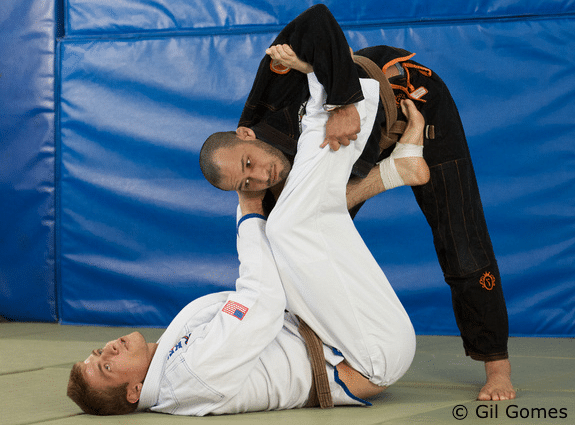
Stephan: You just mentioned the berimbolo, and I’ve seen you do things like 50/50 guard. What do you think about the argument of classic Brazilian Jiu-Jitsu versus a modern Brazilian Jiu-Jitsu, both in terms of both competition and in terms of self-defense?
Keenan: If you’re looking for self-defense, I can’t think of a better position than to put someone in 50/50. If you’re getting beat up and you put someone in 50/50, they’re not going to be able to get you anymore…
Stephan: …and you can rip their knee off.
Keenan: There’s a time and place for everything. 50/50 and the double guard pull stuff, it’s a part of the game now. There are people out there who, if I couldn’t play that game with them, then it’d be much harder to beat them. So it is a game and if you don’t like the game, don’t play the game.
You’ve got to take it all in stride. Those people who like to stick to classical Brazilian Jiu-Jitsu and the traditional styles… well you can live by the sword but you’re going to get shot by those who don’t (laughing).
It’s all Jiu-Jitsu and it comes down to it. That’s like saying, “I hate new technology. I’m going to stick to using Windows 98.” New stuff comes out. That’s just how it is.
Stephan: Just to play the devil’s advocate for a sec here… There are people say, “So long as there is double guard pulls going on, Jiu-Jitsu is never going to be an Olympic sport” and stuff like that. And you see competition like Abu Dhabi trying to find ways to make the sport a little bit more spectator friendly. If you were magically in charge of the IBJJF rules, what would you change to try and make it more spectator-friendly, or maybe even television-friendly, if your goal was to grow the sport that way?
Keenan: You know what? Jiu-Jitsu is Jiu-Jitsu. I think if we were to try and change it to make it more spectator-friendly then bad things would come of that too Like judo for instance – they eliminated a ton of stuff in judo and today it’s totally warped. And like a lot of people don’t like that about judo. A lot judo guys enjoy Jiu-Jitsu more.
I was training with a guy two nights ago – Travis Stevens – who was a judo Olympian. He says he trains judo to pay the bills but his true love is Jiu-Jitsu. So I think what’s beautiful about Jiu-Jitsu is that, sorry, it’s not a spectator sport. It’s for the competitors. It’s for the people who train it.
Like if you train it, you’re going to enjoy watching it. There are boring matches and there are good matches just like in any sport. There can be boring matches and there can be barn burners. But not every match is going to be exciting. Not every MMA fight is exciting. There are some super boring MMA fights.
In BJJ there are some really exciting matches like Buchecha vs Rudolfo. That was an awesome match. Buchecha vs Galvao too – those matches are awesome, and then you have other matches that are really boring.
People watch jiu-jitsu and they expect every match to be really exciting. That’s just unrealistic especially when it’s a sport where amateurs are competing in the public eye like blue belts and purple belts and brown belts. Those guys aren’t even professionals. They’re not even the pros. So how are you going to complain about what they do? They’re amateurs. Sorry, not everyone can be exciting.
Stephan: I suppose the cable television networks make bass fishing a spectator sport. Somehow they make that watchable…
Keenan: Exactly. Can you name some of the other really exciting sports in the Olympics? Well there are actually some crazy sports there that I wouldn’t call exciting, but there are people out there that enjoy them and so they’re in there.
I think more than anything, as Jiu-Jitsu grows, and is more in the public eye, and people start to recognize it and know about Jiu-Jitsu… It used to be that you could ask someone about Jiu-Jitsu and they wouldn’t know what it was, but you could ask someone about judo and they would kind of understand “Oh yeah, I know about judo.” Now, it’s kind of the other way around. Almost everyone knows about Jiu-Jitsu. You can walk up to anyone on the street and “Hey, you know Jiu-Jitsu?” and they go “Oh, yeah. It’s the stuff with the Gracies in the UFC. Yeah. I heard about that”
So I don’t think the sport needs to change much, time just needs to pass as it grows.
Stephan: The other day I was downtown and I saw a couple of homeless guys fighting and they were actually trying to apply guillotine choke from the guard. And so you know the sport is growing…
Keenan: It’s funny. I’ve seen that too. I’ve seen hobos in Hawaii actually trying to armbar each other…(
Stephan: (Laughing) A sheriff friend of mine was saying that to change their pat down procedures because guys were starting to go for rolling kneebars when they were up against the wall with their hands on the wall, being patted down. I’m not exactly sure what they changed technically, but it shows that it really is penetrating into the public consciousness.
Keenan: Yeah. So to all those people that are complaining about double guard pull and stuff, they’re just complaining to complain. Nothing’s forcing you to watch those matches… If you know that’s what’s going to happening and you don’t like it, don’t watch the match.
A lot of times there can be some really cool stuff from double guard pull leg. I have a 50/50 arm bar from there. I just hit a 50/50 arm bar and double guard pull last weekend at the Pan-Ams. So there are still cool stuffs happening and…
Stephan: (Interrupting) Congratulations on your performance Pan-Ams performance by the way.
Keenan: Thank you. I’m not too happy with it. It is a little slow paced. I wasn’t as explosive as I would liked to be. I didn’t push the pace as much.
Stephan: Why do you think that was? Was it nerves or exactly a screw up?
Keenan: I was going through a lot at that point. I wasn’t really in a good place mentally or physically. I wasn’t really set in to a good strength and conditioning program yet after the move. I wasn’t feeling 100% so in some of my matches I kind of went into competition mode just to make sure I won, because I have a goal. I want to double gold grand slam again. So that’s really important to me…
Stephan: You’ve got quite the incredible highlight reel, so I guess you can be forgiven for not every match being a highlight reel performance…
Keenan: Yeah. I still got some cool moves but there are a couple that are kind of like “eh.” But I got another 50/50 arm bar on one of the Miyao brothers so I was happy about that, because those guys are killers.
Stephan: You know what? After this conversation’s over, I’ll try and hit you up for a video of that 50/50 armbar and we’ll throw it onto Grapplearts.com.
Video: Keenan breaks down the armbar from 50/50 guard…
As we’re finishing up this conversation I’ve got a question but it’s kind of weird to ask you this… You’ve been training so hard at a high level and most normal people can’t. Most people have a job. They’ve got kids. They’re lucky to train three or four times a week and they’re also starting out.
I’ll break this into two questions. First, what advice would you have for somebody who is just starting out? It’s their first week in Jiu-Jitsu. How could you help them along?
Keenan: It’s kind of like starting anything: the first month is going to be a little weird. Everything’s going to be completely new and different and at that point I think you should just stick to what your instructor tells you. Try not to do too much on your own. Try not to go and find the fanciest techniques. That’s probably the biggest thing. Fight the urge to go and look up cool moves.
You’ve got to build base first. I like to think that your entire Jiu-Jitsu game is a pyramid and the topmost peak of your pyramid are the fancy techniques and the cool submissions and the berimbolo stuff. Towards the bottom is the base; like understanding closed guard, and how to hold mount, and just understanding what happens when two people roll with each other.
You start trying to build a pyramid by throwing the top point of the pyramid on top first and start dropping those blocks then there it’s just going to be a big pile of rubbish at the end. So you’ve got to start with those fundamentals, thee foundation, and build from there.
I went through that as well when I started out – just looking for the cool moves – and my fundamentals suffered for my first five years or so. Who knows? Maybe that’s that the reason I wasn’t doing well. Then when I finally got my fundamentals sound, I started doing better in competition.
I’d say that’s the biggest thing as far as a beginner goes.
Stephan: Now what about somebody who’s been into it for a couple of years but again, can’t devote a third as much time as you devote toJiu-Jitsu? What advice would you have for them, especially if they want to compete a little bit, if they want to get better, if they want to eventually get their black belt? They already know that the black belt is going to take them ten years, 12 years to get…
Keenan: There’s nothing wrong with that. Jiu-Jitsu is a hobby for everyone, even the full time competitors. I do this because I enjoy it. You don’t find anyone out there doing Jiu-Jitsu because they hate it. It’s not one of those things.
Ultimately, it’s just a game. There’s nothing serious about it. We’re just a bunch of guys who found a way to fight without anyone getting hurt and that’s fun. So, we put on our big goofy gis and we basically just roughhouse for a couple of hours every day. And then there are a couple of guys who take it more seriously…
I’d compare us to professional video game players. It’s just a game and we – the competitors – have just spent a huge amount of time trying to get really good at a very unique and specific set of rules that make up our game.
And so if you want to get good at a game, you got to put in the practice. And if you have other things in your life that take away from you putting the time to get really good at this really complex thing, it’s just going to take you more time. And that’s not a big deal as long as you enjoy the journey. It’s not the destination, it’s the journey.
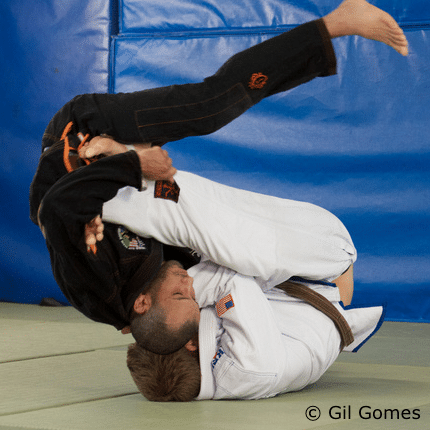
Stephan: Where do you see yourself with this whole Jiu-Jitsu thing in five to ten years? Are you considering MMA or do you want teach seminars or do you want to open your own school eventually?
Keenan: I would like to fight in MMA, just because I think that would be really cool. I’ve actually trained MMA before and I enjoy it and I think I have a knack for it. I think I can do well with it. So eventually I’m going to do MMA, but I have to really steep goals for myself in Jiu-Jitsu that I want to accomplish first. I just like the art of Jiu-Jitsu. It’s something that came naturally to me when nothing else ever really did, so it has this special place in my heart. Who know, I may just do Jiu-Jitsu for the rest of my life…
I don’t think about it too much. I’m just going to keep doing what I’m doing and whatever happens, happens. I may end up opening a school. I may just teach seminars. I may just keep training. I don’t know. Mostly, I really just want to pursue mastery of my chosen art.
Stephan: You’re being here now! Well on behalf of myself, and the Grapplearts readership and listenership, thank you so much for this interview. You’re really cool and you’d give us some good perspective on what goes on inside the head of a competitor such as yourself.
Keenan: Awesome. Thank you so much for the opportunity.
And to be notified of new articles and interviews, and also receive Stephan’s acclaimed Roadmap for BJJ book, sign up for the FREE Grapplearts.com Newsletter by clicking here.
